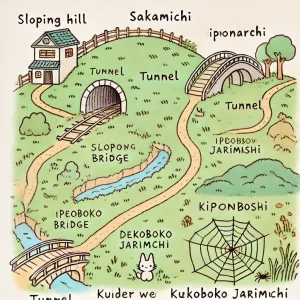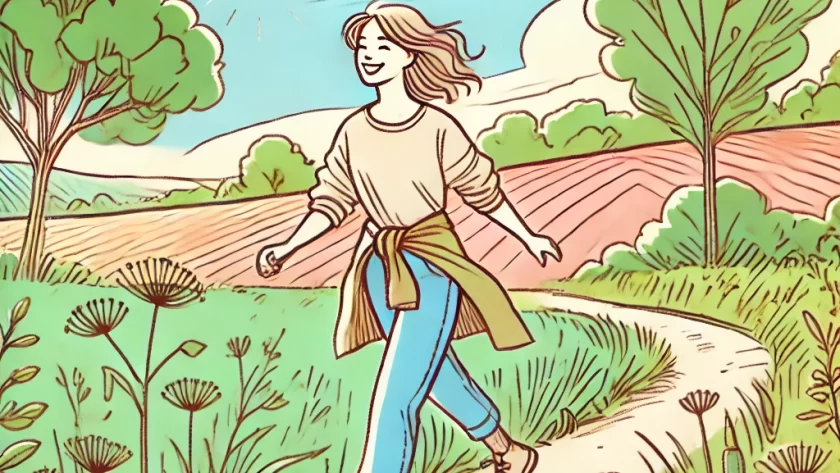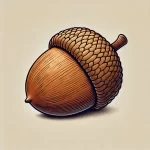さんぽ [Sanpo]
井上あずみ [INOUE Azumi]
Words : 中川李枝子 [NAKAGAWA Rieko]
Music : 久石譲 [HISAISHI Jō]
“My Neighbor Totoro web” (となりのトトロ / Tonari no Totoro) is an animated film produced by Studio Ghibli, released in 1988. The story is set in 1950s Japan and follows the adventures of the Kusakabe family sisters, Satsuki and Mei, who move to the countryside and encounter a mysterious creature named Totoro, said to be visible only to children.
Following the theme song “My Neighbor Totoro” introduced yesterday, today we are covering the opening theme “Hey Let’s Go (Sanpo).” This song is also very popular among children in Japan and is sometimes classified as a nursery rhyme. The English version seems to be equally popular. Today, please listen to the original version.
- 散歩(さんぽ) [sanpo] : walking
The Japanese title is “さんぽ / sanpo,” which refers to walking for relaxation or health. When there is a specific purpose, it is not referred to as “sanpo.” The singing style in the English version, “Hey Let’s Go,” feels more energetic. This might reflect the difference between “Go” and “Sanpo.”
In the film, Mei explores the neighborhood alone while her sister Satsuki is at school. If you’ve seen the movie, imagine Mei’s actions as you read.

あるこう あるこう わたしは げんき
arukō arukō watashi wa genki
- 歩く(あるく) [aruku] : walk
- 私(わたし) [watashi] : I
- 元気(げんき) [genki] : energetic, healthy
(translation) “Let’s walk, let’s walk, I am cheerful.”
“歩こう / arukō” also appears in the classic song “Ue o Muite Aruko (Sukiyaki).”
“元気 / genki” can mean energetic or healthy. The most common phrase corresponding to “How are you?” is simply “元気? / genki?”
あるくの だいすき どんどん いこう
aruku no daisuki dondon ikō
- 大好き(だいすき) [daisuki] : love, like very much
- どんどん [dondon] : quickly, steadily
- 行く(いく) [iku] : go
(translation) “I love walking, let’s go quickly.”
“どんどん / dondon” is an onomatopoeia that has appeared many times in the blog. The dictionary describes it as “the state of things progressing energetically or without hesitation.” Mei’s actions are truly “どんどん.”
さかみち トンネル くさっぱら
sakamichi tonneru kusappara
いっぽんばしに でこぼこ じゃりみち
ipponbashi ni dekoboko jarimichi
くものす くぐって くだりみち
kumonosu kugutte kudarimichi
- 道(みち) [michi] : road, path
- 坂道(さかみち) [sakamichi] : slope, hill
- トンネル [tonneru] : tunnel
- 草原(くさっぱら) [kusappara] : grassy field
- 一本橋(いっぽんばし) [ipponbashi] : narrow bridge
- でこぼこ [dekoboko] : uneven, bumpy
- じゃり [jari] : gravel
- くもの巣(くものす) [kumonosu] : spider web
- くぐる [kuguru] : go through
- 下り道(くだりみち) [kudarimichi] : downhill path
(translation) “A slope, a tunnel, a grassy field
A narrow bridge, a bumpy gravel road
Going through a spider web, a downhill path”
Wow, she’ve come quite a long way, encountering various “みち / michi” (paths).
“でこぼこ / dekoboko” is written in kanji as “凸凹.” It describes a surface with bumps and hollows.

あるこう あるこう わたしは げんき
arukō arukō watashi wa genki
あるくの だいすき どんどん いこう
aruku no daisuki dondon ikō
みつばち ブンブン はな ばたけ
mitsubachi bunbun hana batake
ひなたに トカゲ へびは ひるね
hinata ni tokage hebi wa hirune
バッタが とんで まがりみち
batta ga tonde magarimichi
- みつばち [mitsubachi] : honeybee
- ブンブン [bunbun] : buzzing
- 花畑(はなばたけ) [hanabatake] : flower field
- ひなた [hinata] : sunny place
- とかげ [tokage] : lizard
- へび [hebi] : snake
- 昼寝(ひるね) [hirune] : nap
- バッタ [batta] : grasshopper
- 飛ぶ(とぶ) [tobu] : fly
- 曲がり道(まがりみち) [magarimichi] : winding road
(translation) “Honeybees buzzing, a flower field
A lizard in the sun, a snake taking a nap
A grasshopper jumping, a winding road”
あるこう あるこう わたしは げんき
arukō arukō watashi wa genki
あるくの だいすき どんどん いこう
aruku no daisuki dondon ikō
きつねも たぬきも でておいで
kitsune mo tanuki mo dete oide
たんけん しよう はやしの おくまで
tanken shiyō hayashi no oku made
ともだち たくさん うれしいな
tomodachi takusan ureshī na
ともだち たくさん うれしいな
tomodachi takusan ureshī na
- きつね [kitsune] : fox
- たぬき [tanuki] : raccoon dog
- 出る(でる) [deru] : come out
- 探検(たんけん) [tanken] : exploration
- 林(はやし) [hayashi] : forest
- 奥(おく) [oku] : depths
- ともだち [tomodachi] : friends
- たくさん [takusan] : many
- うれしい [ureshī] : happy
(translation) “Foxes and raccoon dogs, come out
Let’s explore, to the depths of the forest
So many friends, it makes me happy
So many friends, it makes me happy”
Foxes and raccoon dogs have been familiar animals to the Japanese since ancient times. They also appear frequently in Studio Ghibli’s film “Pom Poko” (平成狸合戦ぽんぽこ / Heisei Tanuki Gassen Ponpoko).
My Neighbor Totoro also touches on Japanese religious views and animism. To put it simply, it’s about becoming friends with nature.
The film will be screened in theaters in the UK and Ireland starting August 2. I hope many people around the world will watch it.
YouTube Search “Hey Let’s Go”
Thanks for reading! Feel free to comment if you have any feedback or questions.
Follow me on X.



